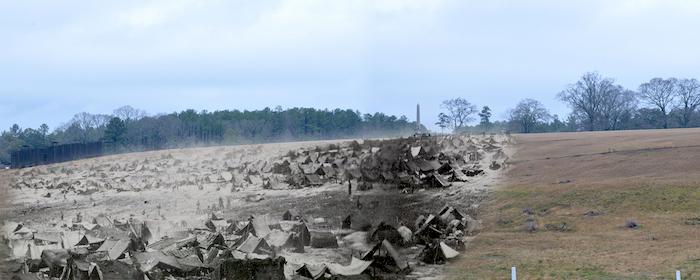
An overlay of a historic photo shows how the Andersonville POW camp looked during the Civil War/NPS
From peanuts to the presidency of the United States is not something many folks can put on their resume. In fact, Jimmy Carter is probably the only one who can.
Former President Carter, who recently conquered cancer, still continues his humanitarian work at the age of 91. But back in 1953 he was deep in peanuts, having taken over his family’s peanut business in Plains, Georgia, following his father’s death. You can explore this aspect of his history, and his successful political climb to the presidency, with a stop at the Jimmy Carter National Historic Site in Plains.
Designated in 1987, the site traces President Carter’s rise from a spot on the Sumter County School Board, to state representative, governor of Georgia, and finally, as the 39th President of the United States. Take a tour through the old Plains High School and the Plains Train Depot (which served as Carter’s campaign headquarters), then stroll the grounds of his boyhood home in nearby Archery, Georgia. They all help illuminate the life of this humble man.
From this uplifting history, head 23 miles north to a much darker chapter of American history at Andersonville National Historic Site. You’ll see the largest prisoner-of-war camp operated by the Confederates during the U.S. Civil War.
During the prison’s operation there were an estimated 45,000 Union soldiers held here. Enduring squalid conditions, nearly 13,000 died. The prisoners had to build their own shelters from blankets and wooden poles, subsist on meager rations, and drink contaminated water that often led to dysentery.
So horrid were the conditions, with so many deaths, that after the war the camp’s commandant, Capt. Henry Wirz, was tried, convicted, and hanged for presiding over Andersonville. A fictional account of the camp, Andersonville, was published in 1955 and won its author, MacKinlay Kantor, the Pulitzer Prize for Fiction the next year.
A tour of the park’s visitor center describes some of the conditions the prisoners endured. Also, photographs by A.J. Riddle, a Confederate photographer who documented the camp’s conditions, line the center’s walls.
Conclude your road trip with a stop at Ocmulgee National Monument in Macon just 61 miles farther north. This site preserves seven Indian mounds, or Earth Lodges. But the story told here goes beyond the mounds. Indeed, it traces 17,000 years of life at this site, established by Paleo-Indian hunters. Around 1,000 BCE these hunters turned into a more agrarian culture, with crops becoming a key part of their diets. The mounds, which began to appear around 1000-900 BCE, served multiple purposes, from burial mounds to council chambers.
Experience, this, and other chapters in Georgia’s rich historical legacy.

Centuries-old earth mounds are protected within Ocmulgee National Monument in Georgia / NPS

 Support Essential Coverage of Essential Places
Support Essential Coverage of Essential Places







Add comment